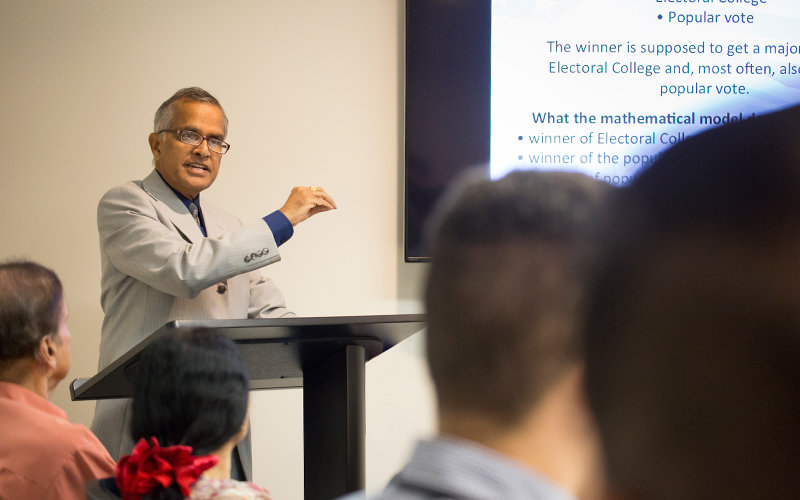
In the tight race for the White House, Cal State Fullerton professor Chandrasekhar Putcha predicts that Democratic nominee Hillary Clinton will become the next U.S. president.
Using an engineering mathematical model he created, Putcha pegs Clinton with 52.78 percent and 284 electoral votes and Republican candidate Donald Trump with 47.21 percent and 254 electoral votes — a 1.9 percent margin of error. A candidate needs at least 270 electoral votes to win the presidency.
Putcha predicts Clinton will take the lead in winning 43.63 percent of the popular vote, with Trump capturing 42.52 percent of the popular vote — a probability with only a .0001 percent margin of error, according to Putcha, who announced his prediction today (Nov. 3).
With presidential election polls in recent days predicting Trump in the lead in some states and Clinton ahead in others, Putcha recalculated the numbers one more time on Monday. While Clinton’s lead dipped from earlier calculations, the probability was the same — Clinton will clinch victory in both the Electoral College and popular vote.
This isn’t the first time the professor has put his math skills to the test to predict the outcome of a presidential election. Putcha is two-for-two: He correctly predicted that Barack Obama would be elected in 2008 and 2012. How? By focusing on the statistics (polling data) and the probability.
Putcha, professor emeritus of civil and environmental engineering, applied probability and statistics — the same principles he uses in engineering analysis. His primary research over his 35-year career focuses on reliability and risk analysis.
For the election prediction, Putcha collaborated with one his former students, 2016 CSUF graduate Vineet Penumarthy, who earned his bachelor’s degree in mechanical engineering in May, and Brian Sloboda, associate chair of the Center for Management and Entrepreneurship at the University of Phoenix. Putcha has worked previously with both on joint research efforts.
Putcha and his team used state-by-state polling data from various sources. For example, in California, polling data from KABC-TV Los Angeles/SurveyUSA, USC Dornsife/Los Angeles Times Poll, Insights West poll and the Field Poll were used to predict a 98.58 percent probability that Clinton will win the state, with 57 percent of the popular vote and all 55 electoral votes.
For North Carolina, the research team used such sources as Public Policy Polling and New York Times Upshot/Sienna College. In that state, Putcha is predicting Clinton to win with 48 percent of the popular vote, compared to Trump’s 44.50 percent.
In Florida, Putcha predicts Trump will prevail by a slim margin of 46.33 percent, compared to Clinton’s 46 percent of the popular vote, capturing 29 electoral votes. The prediction also indicates that Trump will win states such as Arizona, Ohio, South Carolina and Utah.
“The assumption is based on the premise that the polls will capture the pulse of the people as to how they are planning to vote in the actual presidential election,” Putcha said. “If the polling data is correct, the mathematical model that uses this information should predict correctly the outcome of the election.”
CSUF alumnus Penumarthy collected polling data and calculated the probabilities of the winner from each state based on the polling data.
“Polls can be thought of as reactions of the people to any particular event. Using these polls at the state level meant that we could individually look at the reactions of the people in each state and then predict the winner based on these responses,” Penumarthy explained.
Now a graduate student in mechanical engineering at the Illinois Institute of Technology, Penumarthy wanted to be involved in Putcha’s research because of the “sheer bizarreness of the election.”
“I got on board partially due to my interest in statistical analysis, but mostly because I wanted to help predict the winner of the election by just focusing on the mathematics.”
For Putcha, CSUF’s 2007 Outstanding Professor, it has become a challenge to forecast the next U.S. president, and he is looking forward to a three-peat.
“Anybody can always predict, even by simply tossing a coin, and the person may be correct. But there is no mathematical basis for the outcome. I’m confident that our mathematical analysis is accurate in showing that Clinton will win.”
Read more University news related to the 2016 presidential election here.